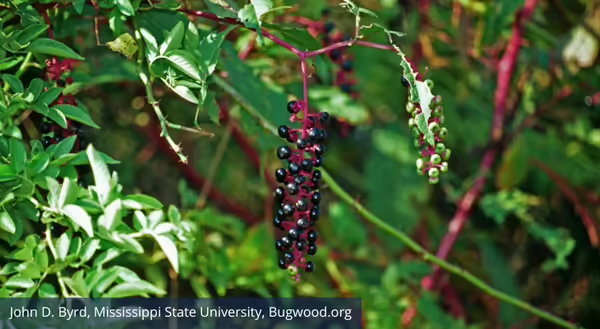
Pokeweed (Phytolacca americana) is a showy plant that makes you stop and ask questions about it whenever it is stumbled upon - whether in your garden or along a hike. From its impressive height, sometimes up to 10 feet tall, to its distinctive reddish-purple stems - you stop and ask yourself: “what is it?” To me, this is the least interesting question you could ask. By observing this showy species, you can ask more interesting questions that tell you so much more about this plant’s ecology and history.
Pokeweed description
After observing Pokeweed over the course of a growing season, you might notice that the plant is a perennial growing from its large taproot to its impressive height with its stem starting from light green and eventually darkening to a brilliant reddish-purple later in the season. Smooth, round, and hairless leaves grow alternately off the stems and in June white or greenish flowers curl at the ends of those stems. Come fall, the inflorescence has shifted from these discrete flowers to showy distinctive berry clusters drooping off the end of the plant and standing out from the green forest floor with its dark purple or black color.
Color, berries and distribution
Just from these physical observations, you might ask yourself “why have such brilliant color?” To which the answer could be that the bright distinctive look of the pokeweed plant makes it distinguishable among bird species for a snack. Turns out, pokeweed is an important food source for songbirds. And that fact indicates the way in which this plant disperses its seeds - through hitching a ride in the birds’ stomachs to be excreted at another location.
The next question you might ask yourself is “why did it succeed here?” And if you had the opportunity to further observe the habitat surrounding this plant you might find it in a fencerow, roadside, drainage ditch, or the forest floor - areas with a history of disturbance.
Pokeweed’s cultural significance
Other questions cannot be answered with observation alone but would need some research. Although this plant seems to be opportunistic – with its ability to colonize disturbed areas, abundant seed heads, and persistence in growth with its deep energy-rich taproot – it is in fact native to Illinois and despite its toxicity has a history as a food staple in the southern United States. This plant has deep roots – pun intended – in many American cultures. From the medicinal and decorative uses by Native Americans to the nutrition source used by many Southerners, this plant goes deeper than its showy look in the forest
Plant toxicity: All parts of the pokeweed plant are considered toxic and botanists and medical professionals do not recommend eating any part of it. That being said, Southerners found that harvesting the leaves and stems early in the spring and proper preparation could make it palatable.
Of course, identification is an important skill. Answering the question, “what is it?”, does tell us about the plant in itself - if you have the established knowledge. However, the understanding of the ecology and historical aspects of our environment unveils a connection we can build with the natural world. It can share with us the importance of local knowledge, build a holistic understanding of ecosystems, and overall grow our appreciation for the adaptiveness and diversity of the natural world.
The next time you come across a plant that you find particularly neat; I encourage you to go beyond the name of the plant or the function it serves you. Ask your neighbors if they have had experience with this plant or if they have seen it around as well. And most importantly - ask more questions beyond - “what is it?”
More about pokeweed
MEET THE AUTHOR: Abigail Garofalo is an Energy and Environmental Stewardship Educator for Cook County. She manages the Cook County Master Naturalist program and the Conservation@Home program for University of Illinois Extension. She has a BS in Natural Resources and Environmental Sciences and MS in Agricultural Leadership Education both from University of Illinois Urbana Champaign. Her background in is environmental outreach and interpretation and works to create a culture of environmentalism through community building.
ABOUT THE BLOG: Naturalist News is a blog by University of Illinois Extension Master Naturalist staff and volunteers who bring you stories highlighting the individuals, places, wildlife, and plants that make this state amazing. Join us each week to learn something new, be inspired and become connected to your own community by recognizing the amazing ways we are all intertwined. Want to get notified when new Naturalist News posts are available? Sign up here!